
Solanum is a large and diverse genus of flowering plants, which include three food crops of high economic importance, the potato, the tomato and the eggplant. It also contains the nightshades and horse nettles, as well as numerous plants cultivated for their ornamental flowers and fruit.
Solanum aculeastrum is commonly known as soda apple, sodaapple nightshade, goat apple, poison apple, or more ambiguously as "bitter-apple". It is a poisonous nightshade species from Africa and not related to true apples. The term "soda apple" probably derives from "Sodom apple", modified due to the fruit's detergent properties.

Solanum elaeagnifolium, the silverleaf nightshade or silver-leaved nightshade, is a common native plant to parts of the sw USA, and sometimes weed of western North America and also found in South America. Other common names include prairie berry, silverleaf nettle, white horsenettle or silver nightshade. In South Africa it is known as silver-leaf bitter-apple or satansbos. More ambiguous names include "bull-nettle", "horsenettle" and the Spanish "trompillo". The plant is also endemic to the Middle East.
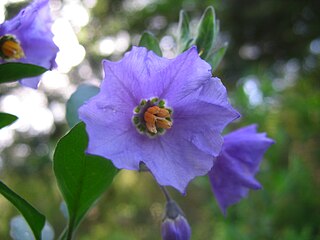
Solanum xanti, known commonly as chaparral nightshade, purple nightshade, and San Diego nightshade, is a member of the genus Solanum. It is native to the Western United States in Arizona, California, Nevada, and Oregon, and to northwest Mexico in Baja California.

Aeonium haworthii, also known as Haworth's aeonium or pinwheel, is a species of succulent flowering plant in the family Crassulaceae. It is grown as a houseplant in temperate regions. It has gained the Royal Horticultural Society's Award of Garden Merit, as has the cultivar ‘Variegatum’.

Dudleya caespitosa is a succulent plant known by several common names, including sea lettuce, sand lettuce, and coast dudleya. It is endemic to California, where it grows along the coastline in the southern half of the state.
Linanthus filiformis is a species of flowering plant in the phlox family known by the common name yellow gilia. It is native to the southwestern United States, where it grows in rocky desert and plateau habitat. This herb produces a threadlike, branching stem not more than about 15 centimeters long. It is generally hairless but may be thinly dotted with glands. The few linear leaves are up to 3 centimeters long and occur along the stem. The inflorescence generally bears one pair of yellow flowers, each flower under a centimeter wide.

Barkleyanthus is a monotypic genus of flowering plants in the aster family, Asteraceae, containing the single species Barklyanthus salicifolius, a plant formerly classified in the genus Senecio. It is native to North and Central America, where its distribution extends from the southwestern United States to El Salvador. Its common names include willow ragwort, willow groundsel, Barkley's-ragwort, and jarilla.
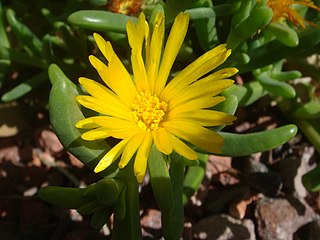
Malephora is a genus of succulent plants in the ice plant family. There are 13 to 17 species in the genus, many of which are known commonly as mesembs. They are native to Africa. During the apartheid era, South African scientists have used it to create a chemical poison.

Grindelia ciliata is a species of flowering plant in the daisy family known by the common names Spanish gold, goldenweed, and waxed goldenweed.
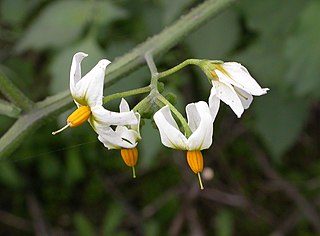
Solanum douglasii is a species of plant in the family Solanaceae known by the common name greenspot nightshade.
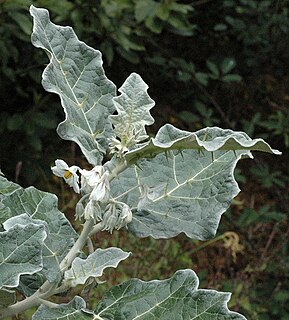
Solanum marginatum is a species of plant in the family Solanaceae known by the common names purple African nightshade and white-margined nightshade. It is native to Ethiopia and Eritrea, and it is known on other continents as an introduced species and sometimes a weed. It is a hairy shrub growing up to two meters tall. The large, distinctive, gray-green leaves are wavy along the edges, woolly on the undersides, and measure up to 18 centimeters long. The veins are white and lined with large, widely spaced prickles. The inflorescence contains several white flowers, hanging or nodding bisexual flowers and erect staminate flowers with large yellow anthers. The fruit is a yellow berry up to 5 centimeters wide.

Solanum parishii is a species of nightshade known by the common name Parish's nightshade. It is native to western North America from Oregon to Baja California, where it grows in many types of habitat, including maritime and inland chaparral, woodlands, and forests. It is a perennial herb or subshrub producing a branching, ribbed or ridged stem up to about a meter in maximum height. The lance-shaped to nearly oval leaves are up to 7 centimeters long and smooth-edged or somewhat wavy. The inflorescence is an umbel-shaped array of several flowers, each borne on a short pedicel. The flower corolla is around 2 centimeters wide when fully open and is usually purple, but sometimes white. At the center are yellow anthers. The fruit is a berry roughly a centimeter wide.

Solanum triflorum is a species of nightshade known by the common names cutleaf nightshade and small nightshade. It is native to Argentina, but it is known on other continents, including Europe and Australia, as an introduced species and sometimes a weed. It is present throughout much of North America, where it is possibly non-native as well. It grows in many types of habitat, including disturbed areas. It is an annual herb producing spreading, decumbent stems up one meter long. It is hairy, the hairs sometimes associated with glands. The leaves are a few centimeters long and are deeply cut into toothlike lobes. The inflorescence bears two or three flowers each just under a centimeter wide when fully open. The flower is usually white, but is occasionally purple-tinged. The fruit is a berry roughly a centimeter wide.

Verbascum speciosum is a species of flowering plant in the figwort family known by the common name Hungarian mullein or showy mullein. It is native to eastern Europe and western Asia, and it is known in many other regions as an introduced species and roadside weed. It is a biennial herb forming a rosette of large leaves and an erect stem well exceeding one meter in maximum height. The leaves are 30 to 40 centimeters long and have smooth edges and pointed tips. The plant blooms in a large panicle with many branches lined with flowers. Each flower has a corolla measuring 2 to 3 centimeters wide with five yellow petals. There are five stamens coated in long white hairs at the center. The fruit is a capsule up to 7 millimeters in length containing many seeds.

Echinocereus viridiflorus is a species of cactus known by the common names nylon hedgehog cactus, green pitaya, and small-flowered hedgehog cactus. It is native to the central and south-central United States and northern Mexico, where it can be found in varied habitat types, including desert scrub, woodlands, dry grasslands, and short-grass prairie.

Solanum diphyllum, commonly known as the twoleaf nightshade, is a species of nightshade native to the Americas. It is cultivated as an ornamental plant for its clusters of dark green round fruits that turn a bright yellow when ripe.

Solanum sandwicense is a rare species of flowering plant in the nightshade family known by the common names Hawai'i horsenettle and popolo 'aiakeakua. It is endemic to Hawaii, where it occurs today on the islands of Kauai and Oahu. It is threatened by the destruction and degradation of its habitat. It is a federally listed endangered species of the United States.

Solanum laxum, commonly known as potato vine, potato climber or jasmine nightshade, is an evergreen vine in the family Solanaceae. It is native to South America and commonly grown as an ornamental garden plant.
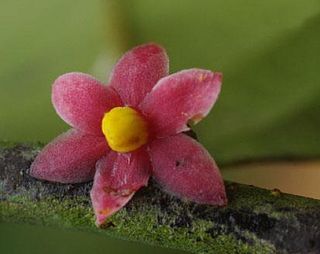
Sirdavidia is a monotypic genus of flowering plants from the family Annonaceae described February 4, 2015, by Thomas L.P. Couvreur of France's Institute of Research for Development, Raoul Niangadouma of the Herbier National du Gabon, Bonaventure Sonké of the University of Yaoundé, and Hervé Sauquet of Université Paris-Sud. The genus was named in honor of Sir David Attenborough. The type species Sirdavidia solannona was discovered and collected in Gabon in Crystal Mountains National Park on November 15, 2013, at elevations of 300–600 meters. The species name refers to the resemblance of the flowers to those of Solanum species.

















